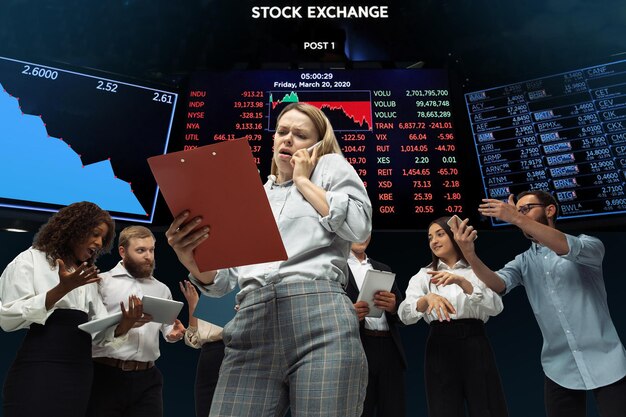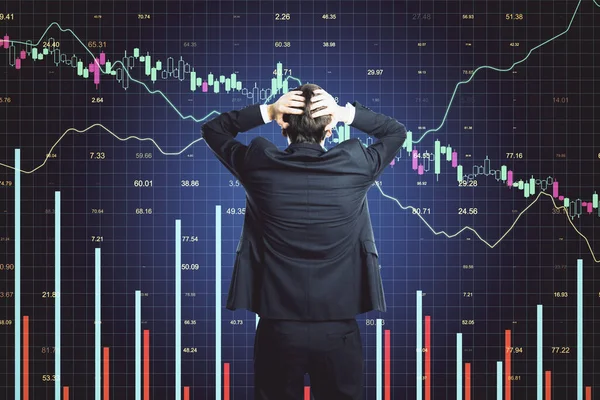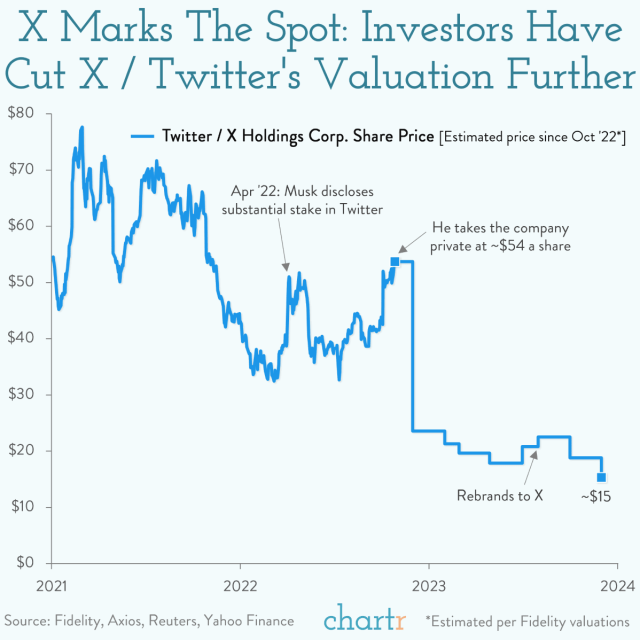Thoughts For Thursday: A Bumpy Ride At The New Year
Two days into the trading year, the stock market has initiated a bumpy ride for investors. It seems there may be a fair amount of up and down action before the market finds its 2024 legs.

Wednesday the S&P 500 closed at 4,705, down 38 points, the Dow closed at 37,430, down 285 points and the Nasdaq Composite closed at 14,592, down 174 points.

Chart: The New York Times
Most actives were led by Tesla (TSLA), down 4%, followed by Ford (F), down 3.7% and Advanced Micro Devices (ADM), down 2.4%.

Chart: The New York Times
In morning market futures activity, S&P 500 market futures are trading up 4 points, Dow market futures are trading up 31 points, and Nasdaq 100 market futures are trading up 26 points.
TalkMarkets contributor Daniel Lacalle starts us off with a new/old topic for 2024 in an Editor's Choice column, The End Of Money As We Know It; What To Expect In 2024.
"Markets closed 2023 with the strongest rally for equities, bonds, gold, and cryptocurrencies in years. The level of complacency was obvious, registering an “extreme greed” level in the Greed and Fear Index."

Image Source: DepositPhotos
"Markets rallied due to a combination of optimistic expectations for inflation and aggressive rate cuts from central banks. The question now is, what can investors expect in 2024?
The year of disinflation can only come from a recession. The market expectations of a massive reduction in inflation cannot come from what economists call a soft landing. The reason we have not seen a recession in 2023 is because the global money supply did not fall below $103 trillion and ended almost at the record level of $107 trillion, according to Citi. Furthermore, governments in developed countries have continued to spend as if inflation and rate hikes did not exist. Fiscal policy has been exceedingly aggressive, while monetary policy has been restrictive. As such, the decline in monetary aggregates and the impact of rate hikes have fallen on the shoulders of the private sector.
Inflation declined in line with monetary aggregates, but we have not yet seen the true impact on the economy because of the lag effect. We are likely to see the full-scale impact of 2023’s monetary contraction in 2024. If the economy weakens and private sector aggregate demand slumps, inflation will decline as expected. However, it is almost impossible to see the kind of goldilocks economy that many investors predict and achieve 2% inflation...
The euro area ended 2023 in recession despite low commodity prices and the EU Next Generation Fund. The problem in the euro area and most Latin American countries is the constant implementation of policies that damage growth and bloat governments. In order to undo the nightmare that collectivist interventionism has created, Argentina will probably go through a detox year.
Due to the monetary destruction that central banks have implemented, equity markets may continue to perform satisfactorily, but volatility will likely rise as market optimism clashes with economic reality. Although 2024 will probably not be the year of central bank digital currencies, they are in the pipeline, and this means even more monetary debasement. In this environment, Bitcoin and gold may continue to support the fight against the destruction of the purchasing power of currencies. We cannot ignore bitcoin’s high volatility and risk, but we cannot forget that it has started to separate itself from other cryptocurrencies to be an asset class of its own.
As central banks prepare the way for digital currencies, which are the closest thing to surveillance disguised as money, reserves of value are more needed than ever before. Gold is likely to be a good de-correlated asset that protects against the debasement of sovereign bonds and domestic currencies.
2024 is likely going to be a year of significant slowdown in the major economies considering the current trends in the private sector and a year of rising public debt, which governments will try to disguise with the destruction of the purchasing power of the currency. In that scenario, betting on the swift end of the inflation burst may be premature. If inflation declines as predicted, it will be a result of the economy’s deterioration and the overspending of the government. If debt and government deficits continue to rise, inflation may surprise on the negative side. Either way, the key in 2024 will be to protect ourselves from currency destruction. Thus, investing is not simply important but crucial to survive in this gradual end of money as we know it."
Lacalle makes some good points, but I am not sure that they lead to his concluding points.
In an "In The Spotlight" column contributor Stephen Innes notes Tech Shares Wobble To Start The Year.
"U.S. stocks slid on the first significant trading day of the new year, signalling a downbeat start to 2024 after a winning year that left the S&P 500 shy of a new record high. The recent rally in stocks stalled on Friday, following two months of gains that contributed to gangbuster performance in the key U.S. benchmarks. The S&P 500, in particular, notched its ninth consecutive weekly win, marking the longest streak since 2004, and is approaching its all-time closing high of 4,796.56.
Tech stocks declined after Barclays analysts downgraded their rating on Apple's stock, expressing concerns about demand for new iPhones. This downgrade contributed to a 1.7% fall in Apple shares as tech stocks slid. Economic updates expected later in the week, mainly the December jobs report due on Friday, could further challenge the ongoing rally. Investors are closely watching the report for its potential to influence the Federal Reserve's reaction function. The prevailing bets on fast and furious interest rate cuts in 2024 have been a critical factor buoying stocks in recent weeks.
Tech stocks, with their rich valuations, are susceptible to the slightest economic wobble or shift higher in yields, and it's not like everyone was participating in this narrow market high driven by A.I. hype."

"In this narrowly focused rally, investors should be less concerned about whether the U.S. enters a recession or if inflation and interest rates deviate slightly from expectations. The critical consideration is the potential bursting of the Technology market cap bubble and its capacity to trigger a broader slump in the global market...
Geopolitical risk, often a key factor influencing oil prices recently, initially supported price action overnight. However, the broader market context, including dismal economic data in China and Europe to start the year and diminishing optimism about U.S. rate cuts, exerted downward pressure during the busy New York session. Coupled with a strengthening U.S. dollar, it contributed to the negative trajectory of oil prices into the Asia session as traders remained on headline watch...
The recent dovish adjustment in Fed rate cut expectations establishes a higher threshold for additional weakness in the U.S. dollar to start the year. To sustain expectations for the Fed to initiate rate cuts as early as March, market participants will likely require a weak U.S. Payroll print but, as importantly, the continued ebbing of U.S. inflation metrics."
In the investment department contributor Tim Knight discusses the X-Dividend.

Buying Twitter (X) was a horrible investment. Investors have cut X/Twitter's valuation further...

Economist and contributor Menzie Chinn explains the Deviation Of Instantaneous Inflation From Target.
"For CPI, CPI core, PCE deflator, PCE core deflator:

Figure 1: Instantaneous inflation (T=12,a=4) for CPI (blue), CPI core (sky blue), PCE deflator (light green), PCE core deflator (red), per Eeckhout (2023). NBER defined peak-to-trough recession dates shaded gray. Source: BLS, BEA, NBER and author’s calculations."
TalkMarkets contributor Steve Sosnick asks if these first trading days of 2024 are A Breather Or A Hangover?
"The new year is less than three days old, but I’ve already fielded several phone calls asking why stocks and bonds have gotten off to a rocky start. That’s typical – I seem to be more popular when markets don’t go up than when they do."

"That’s typical – I seem to be more popular when markets don’t go up than when they do. Frankly, I don’t mind that. It’s a bit more difficult to explain why things aren’t going as planned or hoped. Yet the tone of the questions on down days is usually different. When markets rally, the underlying assumption is that they’re doing what they’re supposed to do. When markets sink, the questions typically have a “what’s wrong” tone.
But here’s the rub: markets can, and sometimes do, go up for the wrong reasons. They can also go down for the right reasons. And vice versa. The challenge is determining which. After a months-long party, that determination becomes more critical.
When we consider the recent rally in stocks, bonds, and pretty much any risk assets, there were plenty of reasons why it was based upon the “right” reasons. We had gotten very oversold at the end of October. No one seemed to want to buy 10-year Treasuries with a 5% yield, and stocks were reflecting negative expectations ahead of the November 1, FOMC meeting...
Who said, “Sure, we know that the median SEP, or dot plot, projection is for 3 rate cuts in 2024. So, by all means, project 6 cuts for 2024 anyway.”?
a. Fed Chair Jerome Powell
b. New York Fed President John Williams
c. Chicago Fed President Austan Goolsbee
d. None of the above
The answer of course was “D”. Having noted that six rate cuts are completely inconsistent with the “soft landing” anticipated by equities...
Having enjoyed the spiked punch for several weeks, investors can’t be blamed if they are experiencing a bit of a hangover.The year-end factors that drove momentum are now behind us, so it is quite fair for investments to take a bit of a breather. After two trading days, it is far too earlier to know whether we’re experiencing a debilitating hangover or simply taking a well-deserved rest. In the meantime, I continue to be thinking about a comment that I made on December 14, the day after the FOMC meeting:
The contrarian in me is nagged by the feeling that we could be so enthused that we are setting up a situation similar to that of late 2021 into early 2022, when SPX peaked on the first trading day of the new year and sank throughout.
We didn’t peak yesterday, but the overriding idea remains a concern."
See the full article for additional commentary.
Stay tuned.
Have a good one.
Peace.
More By This Author:
Thoughts For Thursday: With War Clouds As A Backdrop The Market Is Set To End The Year On A High
Thoughts For Thursday: Everything That Goes Up Comes Down
Tuesday Talk: CPI Data And FOMC Meeting Hold Back Market Breakout



